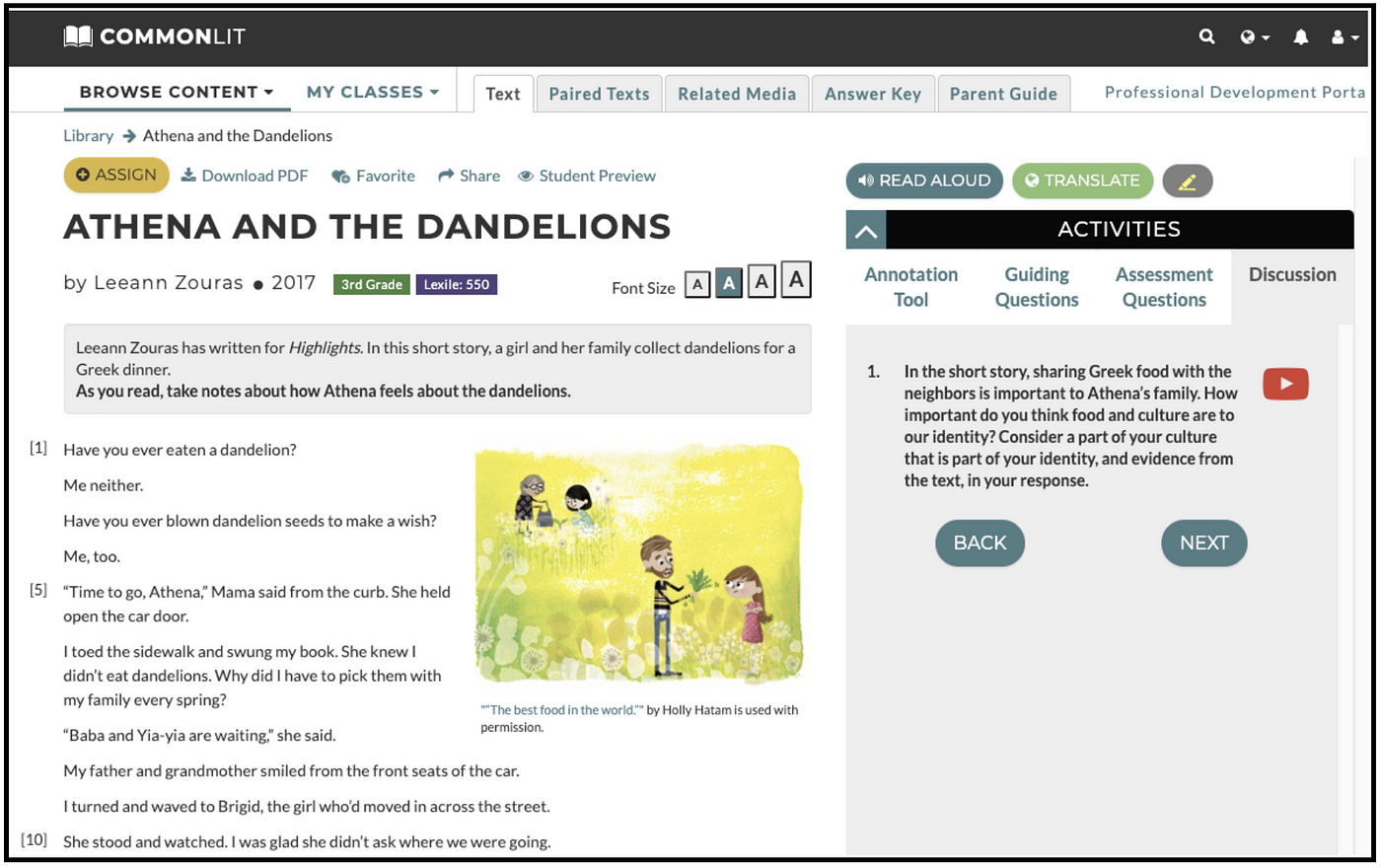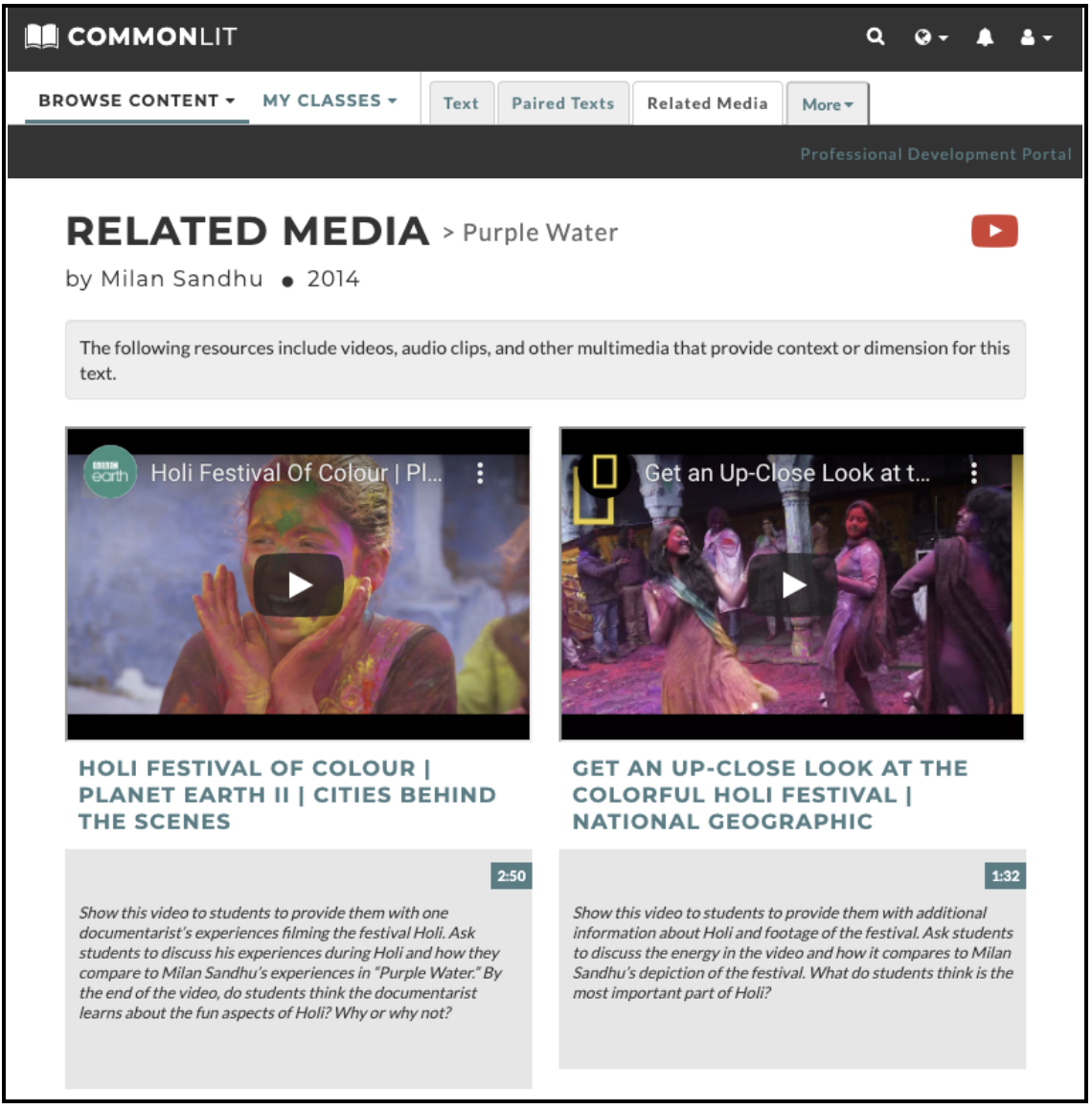CommonLit offers fantastic literary and informational texts that can be used to bolster your students’ understanding of the wide and wonderful world around them!
Great texts can transport you to another place or time — helping you envision things you’ve never seen, walk a mile in someone else’s shoes, and discover the commonalities you share with those who seem so different from you.
Because building knowledge boosts reading comprehension, CommonLit is dedicated to providing teachers and students with access to information-rich, high-quality texts of all genres. The texts that follow are just a few examples of CommonLit’s vast selection of elementary level texts addressing the characteristics, customs, beliefs, and social norms found in cultures around the world. These texts could be used to create or supplement a unit of instruction for your elementary classroom.
“Athena and the Dandelions” by Leeann Zouras
Every spring, Athena and her Greek American family ride to the countryside to pick dandelions. They don’t pick the yellow dandelion flowers for their beauty, nor do they pick the white, fluffy matured flowers to blow the seeds and make a wish. They pick dandelions to “boil, oil, and douse with lemon” as a meal of wild greens, or horta. Athena is embarrassed that her family would eat something that most Americans consider a weed, and she is horrified to find out that her family plans to serve the dandelions at a dinner party for their neighborhood friends.
This sweet story offers valuable lessons in self-acceptance and open-mindedness and comes with great discussion questions to engage your younger readers. One such question asks students to first consider how sharing their Greek food was important to Athena’s family; then, students are asked to discuss whether food is important to their own cultures and what part of their family’s culture is important to their own unique identities.

“Purple Water” by Milan Sandhu
No, this text is not about the multi-talented singer-songwriter Prince. However, this fun — and funny — memoir about Milan Sandhu’s first experience at the Indian festival Holi will leave you smiling, just as if you’re wearing a raspberry beret and driving a little red corvette!
In the memoir, readers are introduced to Holi just as Sandhu was, with a surprise dunk in a vat of purple water. Through the author’s eyes, readers get a sense of the sheer joy brought on by this country-wide celebration — with children and adults roaming the technicolor streets, dancing and playing music, and tossing popcorn and candy in late night bonfires. Beyond just fun, the memoir explains that Holi is a time to celebrate the triumph of good over evil, tribute everlasting love, and revere the coming of the spring season.
Of course, reading about Holi will only make readers want to learn and know more about the colorful festival. Teachers can use the Related Media tab to show students what it’s like being in the middle of the action. After watching the video clips, students can compare the experiences of reading about Holi with seeing and hearing it in action and can then synthesize information for a deeper understanding of this Hindu celebration.

“Birdfoot’s Grampa” by Joseph Bruchac
“Birdfoot’s Grampa” is written from the perspective of a young Native American boy riding in the car with his Grampa. The poem takes a common occurrence many of us have witnessed — noticing frogs congregate on the road when it rains — and shows how the values in one’s culture impacts their everyday actions. While most drivers might see the frogs, slow down, then cringe as they guiltily ease their cars along (leaving several flattened frogs in their wake), Birdfoot’s Grampa hops out of the car time and again on a personal mission to save each and every frog’s life. His reason: “they have places to go to too.”
This poem communicates a core value common in the Indigenous tribes of North America: that all life is equally valuable. Like “Athena and the Dandelions,” it also addresses the struggle of retaining core cultural characteristics across multiple generations. If your students enjoy this poem and want to know more about Native American culture, you can find many great texts of all genres in CommonLit’s Native American History and Authors text set.
“Ataka: A Young Desert Girl” by Victor Englebert
This essay describes the life of Ataka, a young Tuareg girl who lives a nomadic life in Africa’s Sahara Desert. The Tuareg, or “The Blue People’’ as they are named because of the bright blue fabric the Taureg men use to cover their faces and heads, are camel herders. Your students will be fascinated reading about Ataka’s daily life: her family’s customs, her chores, how she withstands the harsh desert sandstorms, and how she and her cousins play.
This text can be used for small group or independent reading with upper elementary students or as a read-aloud text for younger students. Because readers may get tripped up with some of the unfamiliar names in this text, don’t forget that teachers and students have access to the helpful Read Aloud feature. The Paired Texts tab also offers a great companion piece about Tibetan nomads. Together, the two texts offer insight into humans’ ability to adapt to the most extreme conditions.

“Pasha’s First Yom Kippur” by Carol Coven Grannick
Now that Pasha’s family had immigrated to America from Russia, he is finally learning more about his Jewish heritage and traditions. In preparation for his first official celebration of the Jewish holiday Yom Kippur, Pasha reflects on apologizing for the wrongs he has committed and forgiving others. The problem is that Pasha’s neighbor and classmate, David, is constantly teasing him about his native language and accent. Pasha reacts in anger and struggles with how to resolve things honestly. This sweet story follows Pasha as he struggles with — and finally understands — the true meaning of Yom Kippur.
If you like this text and are interested in expanding it into a mini-unit, check out the CommonLit Supplemental Unit titled “Cultures Around the World.” In the unit, students read a total of five texts and collect evidence so they can answer the following question in a multi-paragraph response: How do traditions make different cultures unique?
Next Steps
Looking for more elementary texts or text sets on CommonLit? Browse the CommonLit Library!
If you’re interested in learning all about CommonLit’s free digital literacy program, join one of our upcoming webinars!


